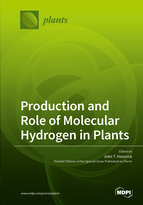Production and Role of Molecular Hydrogen in Plants
A special issue of Plants (ISSN 2223-7747). This special issue belongs to the section "Plant Physiology and Metabolism".
Deadline for manuscript submissions: closed (30 April 2022) | Viewed by 25673
Special Issue Editor
Interests: redox signaling; reactive oxygen species; hydrogen sulfide; hydrogen gas; nitric oxide
Special Issues, Collections and Topics in MDPI journals
Special Issue Information
Dear Colleagues,
Molecular hydrogen (hydrogen gas; H2), is gaining prominence in the scientific literature as well as the popular media. Early pre-clinical and clinical studies suggest the use of H2 treatment for a wide range of human diseases, from COVID-19 to various neurodegenerative diseases. Moreover, its biological activity also appears to have therapeutic and regulatory effects in plants. Accordingly, it has been suggested to be useful in large-scale agricultural settings.
Hydrogen gas has effects on a range of physiological events in plants. It has been shown to have effects on seed germination, plant growth, and development. It has also been found to be involved in plant stress responses and to be protective against pathological abiotic stress challenges. Similarly, it also has beneficial effects during the post-harvest storage of crops. Therefore, its use in the agricultural setting has great potential as it appears to be safe, with no toxicity or harm to the environment.
One of the conundrums of the use of hydrogen gas is how it induces these observed effects in plants and plant cells. It is difficult to envisage how it works based on a classical receptor mechanism. There is some evidence that it may act as a direct antioxidant, especially by scavenging hydroxyl radicals, or via enhancing the plant’s innate antioxidant system as a biological signaling molecule. It has also been reported to exert some effects through action on heme oxygenase, cross-talk with other signaling molecules, and regulating the expression of various genes. However, how molecular hydrogen fits into, and integrates with, other signaling pathways is not clearly understood. Future work is needed to elucidate the mechanism(s) and significance of the interaction of H2 with these and other cellular systems.
This Special Issue aims to bring together a body of papers that focus on the current state-of-play of the molecular biology and possible uses of molecular hydrogen with plants. It is hoped that this Special Issue will highlight the future work which may be undertaken in this field and help to encourage researchers to investigate this exciting field further.
Prof. Dr. John Hancock
Guest Editor
Manuscript Submission Information
Manuscripts should be submitted online at www.mdpi.com by registering and logging in to this website. Once you are registered, click here to go to the submission form. Manuscripts can be submitted until the deadline. All submissions that pass pre-check are peer-reviewed. Accepted papers will be published continuously in the journal (as soon as accepted) and will be listed together on the special issue website. Research articles, review articles as well as short communications are invited. For planned papers, a title and short abstract (about 100 words) can be sent to the Editorial Office for announcement on this website.
Submitted manuscripts should not have been published previously, nor be under consideration for publication elsewhere (except conference proceedings papers). All manuscripts are thoroughly refereed through a single-blind peer-review process. A guide for authors and other relevant information for submission of manuscripts is available on the Instructions for Authors page. Plants is an international peer-reviewed open access semimonthly journal published by MDPI.
Please visit the Instructions for Authors page before submitting a manuscript. The Article Processing Charge (APC) for publication in this open access journal is 2700 CHF (Swiss Francs). Submitted papers should be well formatted and use good English. Authors may use MDPI's English editing service prior to publication or during author revisions.
Keywords
- Antioxidants
- Heme oxygenase
- Hydrogenase
- Hydrogen gas
- Hydrogen-rich water (HRW)
- Molecular hydrogen
- Radical scavenging
- Reactive nitrogen species (RNS)
- Reactive oxygen species (ROS)







